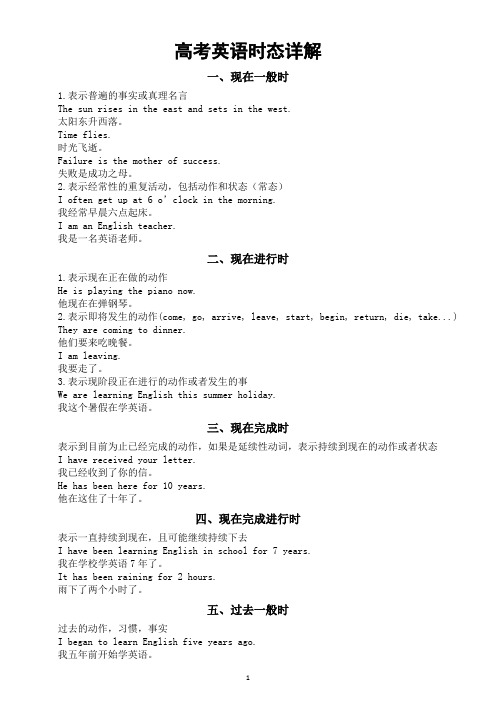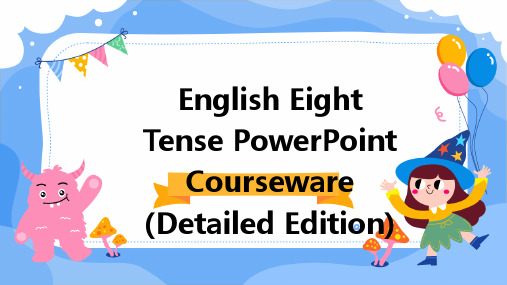高中英语八大时态全套精讲
高中英语16种时态详细讲解

高中英语16种时态详细讲解1.一般现在时(do/does; is/am/are)①表示现在的情况、状态或特征。
例:He is a student.他是一个学生。
②表示经常性、习惯性动作。
例:He always helps others.他总是帮助别人。
③客观事实和普遍真理。
例:The earth moves the sun.地球绕着太阳转。
④表示一个按规定、计划或安排要发生的动作。
仅限于某些表示“来、去、动、停、开始、结束、继续”等的动词,可以与表示未来时间的状语搭配使用。
常见的用法是:飞机、火车、轮船、汽车等定期定点运行的交通方式。
例:The next train leaves at 3 o'clock this afternoon.下一趟火车今天下午3点开车。
⑤在时间、条件和让步状语从句中经常用一般现在(有时也用现在完成时)表示将的来事情。
(即:主将从现原则)例:I will call you as soon as I arrive at the airport.我一到机场就会给你打电话。
When you have finished the report, I will have waited for about 3 hours. 等你完成这份报告的时候,我就已经等了将近3个小时了。
2. 现在进行时(am/is/are doing)①表示此时此刻正在发生的事情。
例:He is listning to the music now.他现在正在听音乐。
②表示目前一段时间内一直在做的事情,但不一定此时此刻正在做。
例:I am studying computer this term.这个学期我一直在学习计算机。
③现在进行时可以表示将来的含义。
a. 瞬时动词的进行一定表将来。
例:I am leaving.我要离开了。
b. 持续动词的进行只有有将来的时间状语或有将来语境中才表将来。
例:I am travelling next month.下个月我要去旅行。
高中英语高考复习时态详细讲解(共16类)

高考英语时态详解一、现在一般时1.表示普遍的事实或真理名言The sun rises in the east and sets in the west.太阳东升西落。
Time flies.时光飞逝。
Failure is the mother of success.失败是成功之母。
2.表示经常性的重复活动,包括动作和状态(常态)I often get up at 6 o’clock in the morning.我经常早晨六点起床。
I am an English teacher.我是一名英语老师。
二、现在进行时1.表示现在正在做的动作He is playing the piano now.他现在在弹钢琴。
2.表示即将发生的动作(come, go, arrive, leave, start, begin, return, die, take...) They are coming to dinner.他们要来吃晚餐。
I am leaving.我要走了。
3.表示现阶段正在进行的动作或者发生的事We are learning English this summer holiday.我这个暑假在学英语。
三、现在完成时表示到目前为止已经完成的动作,如果是延续性动词,表示持续到现在的动作或者状态I have received your letter.我已经收到了你的信。
He has been here for 10 years.他在这住了十年了。
四、现在完成进行时表示一直持续到现在,且可能继续持续下去I have been learning English in school for 7 years.我在学校学英语7年了。
It has been raining for 2 hours.雨下了两个小时了。
五、过去一般时过去的动作,习惯,事实I began to learn English five years ago.我五年前开始学英语。
八大时态讲解(共26张PPT)

0 一般过去将来时:
He was sixty-eight. In two years he would be seventy.
I knew you would agree.
0 现在英进行语时的: 动词时态(进行) What are you doing?
算;
如:I am going to listen to music. (我打算听音乐) will /shall 表示未事先思考或为计划过的意图
如:It will be Christmas soon .(很快就圣诞节了)
4. 现在进行时态( The Present Continuous Tense )
5、我们离开广州六年了。
We have left Guangzhou for 6 years . ×
We have been away from Guangzhou for 6
years .
3.常见句型
1) 主句(现在完成时)+since 从句(一般过去时).
2) It is +一段时间+ since 从句(一般过去时).
has gone to
He said had seen this morning, …ago, etc
that he _________the film many 如果明天不下雨,我们将去野营。
He has borrowed the pen for three days .
times. 现在进行时态( The Present Continuous Tense )
was /were going to +动词原形
高中英语8大时态

高中英语8大时态1. 一般现在时概念: 表示经常发生的动作或经常存在的状态。
常和always , often , usually , sometimes , every day 等表时间的状语连用。
如:1) I go to school every day . 我每天都去学校。
(表经常)2) He is always like that . 他总是那样。
(表状态)构成:1) 主语+ be (am / are / is ) +……2) 主语+ 实义动词/三单动词+ …2.一般过去时概念: 1) 表示过去某个时间发生的动作或存在的状态.常和表示过去的时间状语连用. 如: yesterday , last week , in 1998 , two days ago等.如: I went to a movie yesterday. 我昨天去看了一场电影.2) 也可表示过去经常或反复发生的动作.如: He always went to work by bike last week.构成: 1) 主语+ be (was / were ) +……2) 主语+ 实义动词过去式+3. 现在进行时概念: 表示现在(说话瞬间)正在进行或发生的动作.如: He is singing.They are watching TV now.构成: 主语+ 助动词be(am/are/is) + 动词-ing形式构成.4. 过去进行时概念: 表示过去某一时刻或某一段时间正在进行的动作. 这一特定的过去时间除了有上下文暗示外,一般用时间状语来表示.如: 1) ---What were you doing?---I was jumping.2) ---What was the boy doing when the UFO arrived?---He was sleeping.构成: 主语+ 助动词be(was/were) + 动词-ing形式构成.5. 一般将来时概念: 表示将来某个时间要发生的动作或存在的状态,也表示将来经常或反复发生的动作,常与表示将来的时间状语连用,如: tomorrow, next week, next year, in the future等.如: He will go shopping tomorrow.They are going to play basketball next week.构成: 1) 主语+ 助动词will + 动原+…2) 主语+ be going to + 动原+ ….6. 过去将来时概念: 表示在过去将来的某一时间发生的动作或存在的状态.构成: 1) 主语(第一人称) + 助动词should + 动原+…2) 主语+ would + 动原+ ….3) 主语+ was/ were going to +动原…用法: 过去将来时除了上下文暗示外,一般常用在间接引语中,主句谓语动词为过去时态.如: 1) I should go.2) You knew I would come.3) They were going to Naning.7. 现在完成时构成: 主语+ 助动词( have / has ) + 动词过去分词+…用法例句表示过去发生或已经完成的动作对现在造成的影响或结果. ---Have you had your lunch yet?---Yes, I have. (现在我不饿了)8. 过去完成时构成: 主语+ 助动词had + 动词过去分词+…用法例句表示过去在过去某一时间或动作之前已经发生或完成了的动作.它表示的动作发生的时间是”过去的过去”.表示过去某一时间可用by, before 等构成的短语,也可用when, before, 等引导的从句或者通过上下文表示.I had finished my homework when my mom came back home.。
(完整版)高中语法之常用时态语态详解

第四章时态和语态一.动词的时态英语时态用共有十六种时态,其中常用的有8种,它们是:一般现在时、一般过去时、一般将来时、现在进行时、现在完成时、过去进行时、过去完成时和过去将来时。
一. 一般现在时.1.构成. be动词:am is are ; 其他动词用动词原形,当主语是第三人称单数时要在谓语动词后加“s”,其变化规则与名词变复数一致。
2.用法. 1). 经常性或习惯性的动作,常与表示频度的时间状语连用。
如usually, always, often, seldom, never, every...,eg. I leave home for school at 7 every morning.I don’t leave home for school at 7 every morning.Do I leave home for school at 7 every morning?He usually gets up early.He doesn’t usually get up early.Does he usually get up early?2) 客观真理,客观存在,科学事实。
eg. The earth moves around the sun.The earth doesn’t move around the sun 否定句Does the earth move around the sun? 疑问句Shanghai lies in the east of China.Shanghai doesn’t lie in the east of China 否定句Does Shanghai lie in the east of China? 疑问句Water boils at 100 centigrade degrees.3) 表示格言或警句中eg. Pride goes before a fall.注意. 此用法如果出现在宾语从句中,即使主句是过去时,从句谓语也要用一般现在时。
高中英语英语时态完整版 PPT课件 图文

一、一般现在时
一直以来的习惯动作;目前状态;规律
一般现在时
单三人称:动词 s或es 非单三人称:动词原形
动词第三人称单数的变化规则
1、直接在动词后+s
like- likes
play-plays
2、以s, x, sh, ch, 接尾的动词:+es
wash-washes
3、以辅音+o接尾的动词:+es
go-goes
4、以辅音+y接尾的动词:变y为i+es
fly-flies
一、一般现在时的用法
1) 经常性或习惯性的动作,常与表示频度的时间状 语everyday, often, always, once a week, seldom, usually等连用。
I leave home for school at 7 every morning. He cycles to work every day. 2) 客观真理,客观存在,科学事实。 The earth moves around the sun. Shanghai lies in the east of China. Water boils at 100 centigrade degrees.
一、基本概念:
过去将来时表示从过去的某一时间看将要发生的动作或存在的状态。 它是一个相对的时态,即立足于过去某时,从过去的某一时间看即 将发生的事情就要用这一时态。 1) He said his mother would buy a bike for him 2) My brother told me he wouldn’t believe Jack any more. 3) Would it be all right if he knew his illness?
英语八大时态PPT课件(详细版)

The perfect tense is formed by combining the presentation
particles of the verb with have or has (e.g., he has gone, she has come)
The Composition of the Eight Tenses in English
03
Examples
I have studied, They have played, He has written
Present simple tense
Definition
The present simple tense is used to express an action that is verbal, generic, or not emphasizing time
VS
Tense can be classified into two categories: simple tense and complex tense Simple tense includes present, past, and future tense, while complex tense includes the perfect, the superior, the future perfect, and the conditional perfect tense
Conditional Perfect Tense
It is used to express actions or events that would have been completed in the past if a condition had been met
高中英语时态8种基本时态归纳

高中英语时态8种基本时态归纳
高中英语中有8种基本时态,分别是:
1. 现在时:表示现在正在进行或经常性的行为或状态,例如:
I am eating breakfast.(我正在吃早餐。
)
2. 过去时:表示过去发生的行为或状态,例如:He studied in Beijing last year.(他去年在北京学习。
)
3. 将来时:表示将要发生的行为或状态,例如:They will come to the party tonight.(他们今晚会来参加派对。
)
4. 现在进行时:表示正在进行的动作或状态,例如:She is writing a letter.(她正在写信。
)
5. 过去进行时:表示过去正在进行的动作或状态,例如:I
was walking along the street when I saw her.(我正在街上走,突然看到了她。
)
6. 现在完成时:表示过去完成的动作对现在有影响或结果,例如:He has finished his homework.(他完成了作业。
)
7. 过去完成时:表示过去某个时间之前已经完成的动作或状态,例如:By the time she arrived, I had already left.(她到达时,我已经走了。
)
8. 将来完成时:表示将来某个时间之前已经完成的动作或状态,
例如:By this time next week, I will have finished the project.(到下周的这个时间,我会完成这个项目。
)。
- 1、下载文档前请自行甄别文档内容的完整性,平台不提供额外的编辑、内容补充、找答案等附加服务。
- 2、"仅部分预览"的文档,不可在线预览部分如存在完整性等问题,可反馈申请退款(可完整预览的文档不适用该条件!)。
- 3、如文档侵犯您的权益,请联系客服反馈,我们会尽快为您处理(人工客服工作时间:9:00-18:30)。
基础课程教学资料
高中英语八大时态全套精讲
英语共有十六种时态,其表现形式如下(以study为例):
时态
一般时进行时完成时完成进行时
现在study be studying have studied have been studying
过去studied be studying had studied had been studying
将来will study will be studying will have studied will have been
studying
过去将来would study would be
studying would have
studied
would have been
studying
.1 一般现在时的用法
1) 经常性或习惯性的动作,常与表示频腮度的时间状语连用。
时间状语:every…, sometimes, at…, on Sunday
I leave home for school at 7 every morning.
2) 客观真理,客观存在,科学事实。
The earth moves around the sun. Shanghai lies in the east of China.
3) 表示格言或警句中。
Pride goes before a fall. 骄者必败。
注意:此用法如果出现在宾语从句中,即使主句是过去时,从句谓语也要用一般现在时。
例:Columbus proved that the earth is round..
4) 现在时刻的状态、能力、性格、个性。
I don't want so much. Ann Wang writes good English but does not speak
well.
比较:Now I put the sugar in the cup. I am doing my homework now.
第一句用一般现在时,用于操作演示或指导说明的示范性动作,表示言行的瞬间动作。
再如:Now watch me, I switch on the current and stand back. 第二句中的now是进行时的标志,表示正在进行的动作的客观状况,所以后句用一般现在时。
二. 构成及变化
1、be动词的变化
肯定句:主语+be(am,is,are)+其它。
如:I am a boy. 我是一个男孩。
否定句:主语+ be + not +其它。
如:He is not a worker. 他不是工人。
一般疑问句:Be +主语+其它。
如:-Are you a student? -Yes. I am. / No, I'm not.
特殊疑问句:疑问词+一般疑问句。
如:Where is my bike?
2、行为动词的变化
当主语为第一,二人称及复数时,助动词为do
肯定句:主语+动词原形(+其它)。
如:We often play basketball after school.
否定句:主语+ don't+动词原形(+其它)。
如:we don’t play basketball after school.
一般疑问句:Do +主语+动词原形+其它? 如:Do you often play basketball after school l? Yes, we do. / No, we don't.
特殊疑问句:疑问词+以do开头的一般疑问句? 如:What do you often do after school ?
当主语为第三人称单数时,助动词为does
肯定句:主语+动词三单式(+其它)。
如:He swims well.
否定句:主语+ doesn’t+动词原形(+其它)。
如:He doesn’t swim well..
一般疑问句:Does +主语+动词原形+其它。
如:Does he swim well ?
Yes, he does. / No, he doesn't.
特殊疑问句:疑问词+以does开头的一般疑问句?
如:How does your father go to work?
三、第三人称单数的动词变化规则(只有在第三人称为主语的肯定句中,动词才用三单式)
(1)多数动词直接加s:
runs gets likes collets takes plays climbs…….
(2)结尾是s, x, sh, ch, o,前为辅音字母,结尾加es :
watches teaches goes does washes crosses mixes brushes
(3)动词末尾y前为辅音:将y改为i加es:
study→studies fly→flies carry→carries cry→cries
但在y前如果为元音则直接加s:
buys says
2 一般过去时的用法
1)在确定的过去时间里所发生的动作或存在的状态。
时间状语有:yesterday, an hour ago, the other day, in 1982 yesterday morning (afternoon, evening…) last night (week, month, year…), a moment ago , a week ago, three years ago…just now,等。
Where did you go just now?
2) 表示过去习惯性动作。
特别是由would/ used to do表达的句型,本身表示的就是过去时。
例:The old man would sit on a bench in the quiet park and look at others for hours
without doing anything or talking to anybody.(老人过去常常坐在宁静的公园里的一条
长椅上,看着其他的人,一坐就是数个小时,什么也不干,也不和任何人交谈。
)He used to visit his mother once a week.(他以前总是每周看望一次他的母亲。
)3) 有时可代替一般现在时,表达一种婉转、客气、礼貌、商量的语气。
情态动词could, would.
例:I wanted to ask you if I could borrow your car?(我想向您借车用一用,可以吗?)
Would you mind my sitting here?(您介意我坐在这里吗?)
典型例题
---- Your phone number again? I ___ quite catch it.
---- It's 69568442.
A. didn't
B. couldn't
C. don't
D. can't
答案 A. 本句虽没有明确的时间状语,但从语意上看出,在听的时候没有听懂这个动
作发生在过去,因此应用过去时。
二、构成及变化
1. Be动词在一般过去时中的变化:
am 和is在一般过去时中变为was。
(was not=wasn’t)
are在一般过去时中变为were。
(were not=weren’t)
带有was或were的句子,其否定、疑问的变化和is, am, are一样,即否定句在was或were后加not,一般疑问句把was或were调到句首。
2.行为动词在一般过去时中的变化:
肯定句:主语+ 动词的过去式 .
I watched a film last Sunday .
否定句:主语+ didn’t + 动词原形.
I didn’t watch a film last Sunday .
一般疑问句:Did + 主语+ 动词原形?
Did you watch a film last Sunday ? Yes, I did . No , I didn’t .
特殊疑问句:疑问词+ 以did 开头的一般疑问句?
What did you do last Sunday ?
3、现在进行时( be doing)
一、意义——当表示现在正在进行的动作或正在发生的事。
时间标志——now,句前的look ,listen
二、构成:be (am, is ,are )+动词现在分词-ing形式。
